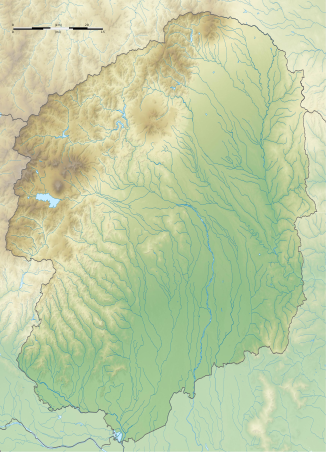Kegon Falls
| Kegon Falls | ||
|---|---|---|
|
Kegon Falls, Nikko National Park , Tochigi Prefecture , Japan |
||
| Coordinates | 36 ° 44 '16.5 " N , 139 ° 30' 7.1" E | |
|
|
||
| place | Tochigi , Japan | |
| height | 97 m drop edge : 1269 m TP Impact zone : 1172 m TP |
|
| width | 7 m | |
| Number of fall levels | 1 | |
| Falling watercourse | Ōshiri from Lake Chūzenji | |
| Estuarine waters | Daiyagawa → Kinu → Tone | |
The Kegon Falls ( Japanese 華 厳 滝 ; Kegon-no-taki ) are waterfalls on the Ōshiri River , the outlet of Lake Chūzenji . They are located in the Nikkō National Park in the area of the city of Nikkō in Tochigi Prefecture in Japan .
The falls formed when the Daiyagawa River was dammed by lava flows from the Nantai Volcano about 20,000 years ago . Twelve smaller waterfalls lie below the Kegon Falls or parallel to them. The water exits through numerous crevices between the mountains and the lava flows.
The fall height is 97 m. Along with Nachi Waterfall in Wakayama Prefecture and Fukuroda Waterfall in Ibaraki Prefecture, it is considered to be one of the three most beautiful waterfalls in Japan.
Until 1900, when Hoshino Gorobei built a tea house by the basin, the Kegon Falls were relatively isolated.
The Kegon cases are notorious for suicide , especially among Japanese teenagers.
The Japanese widow Nobu Jo decided to devote her life to helping and saving those unfortunate people who wanted to “leave earthly life through a back door”, as it is called in Japanese. So she inscribed a wooden stake with the inscription: "Stop if you are in need, turn to Ms. Nobu Jo before the last step." Since her efforts and their success quickly became known, she received donations that enabled her to To found homes in which the tired of life, mostly women, could live until their mostly family situation had normalized. Ms. Nobu Jo worked in other parts of Japan for over fifteen years, preventing countless suicides.
Suicides
In 1903 the student Fujimura Misao committed suicide at the waterfall. Because of his poetic suicide note carved into a tree trunk and Fujimura's family origin, his death was glorified by the newspapers and commented on by the famous writer Natsume Soseki , so that in the following eight years more than 200 suicide attempts were made by young people ( Werther effect ).
Individual evidence
- ↑ a b c d Kegon Waterfall. Nikko Tourist Association, archived from the original on April 14, 2012 ; accessed on February 15, 2010 (English).
-
↑ One woman saves 12,000 people, A life for the tired of life. In: The Bern Week in Words and Images , Vol. 27, 1937, pp. 232–233. ( e-periodica )
- ↑ Mamoru Iga, Joe Yamamoto, Thomas Noguchi , Jushiro Koshinaga: Suicide in Japan . In: Social Science & Medicine. Part A: Medical Psychology & Medical Sociology . Volume 12, 1978, pp. 513 , doi : 10.1016 / 0271-7123 (78) 90118-9 .


